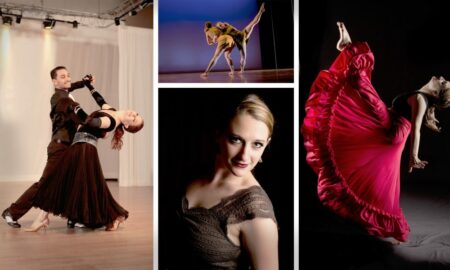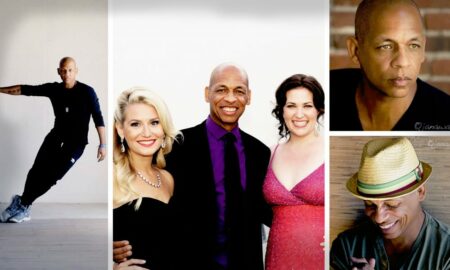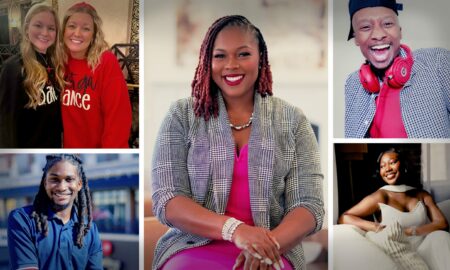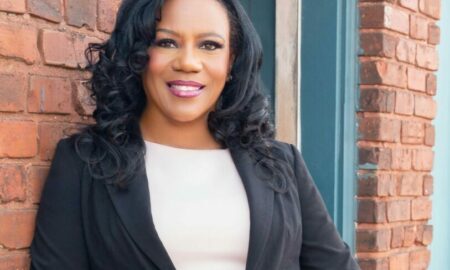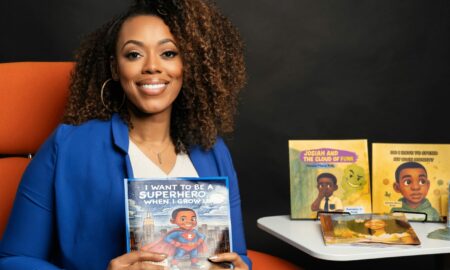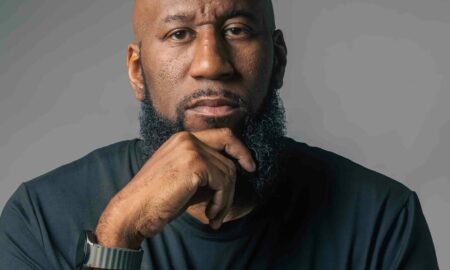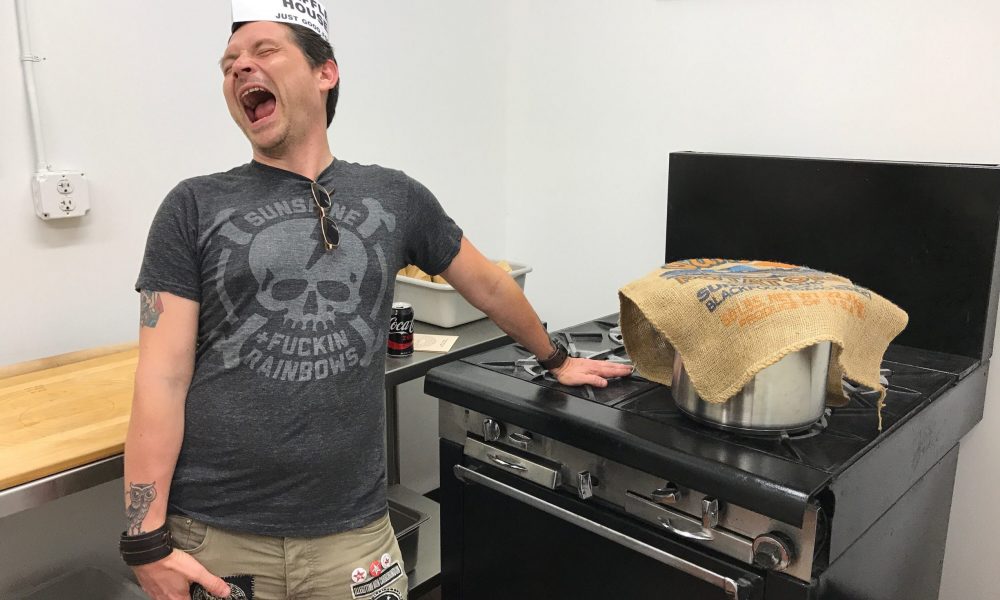

Today we’d like to introduce you to Christopher Hall.
Every artist has a unique story. Can you briefly walk us through yours?
I was born on December 16th, 1975, miraculously with a crayon in my hand… born to paint! But I didn’t know I wanted to pursue art as a career until one particular moment while I was in high school. I picked up some skills from my visual arts teacher, but I don’t think I got much more than that. My music teacher, however, had a lasting impact on me. I was taught the value of hard work and of developing a passion for what you do. I played trumpet at the time because I wanted to play the loudest instrument in the symphony. I had something to say and I wanted people to hear me! Well, we were playing Shostakovich’s Symphony No. 5, the Allegro non Troppo. There was a quiet part in the middle, so I took a look out into the audience, and there, in the front row I saw an old woman crying. I thought to myself, “We did that!” I knew what I wanted to do for my career after that: make old women cry!
I decided to go back to my first love, visual art, for my undergraduate studies at the University of Georgia. I think I felt most confident in that medium, though music and writing were close runner-ups. In fact, I fronted a few bands during this time and pursued some experimental sound art (which I continue to do). I also pursued an English Literature minor (English Romantic poetry, Shakespeare, Melville, Hesse, and Cervantes were favorites) and I had my first writings published. I’ve always been on the border between the stereotypes of the wild Dionysian rock star spouting ecstatic poetry and the more critical life of the mind experiences that come with my academic background.
Athens, Georgia is kind of a Land of the Lotus Eaters to me, a Peter Pan land. I lived the rock and roll lifestyle there for twelve years. I made some great friends, but it became a world of unfulfilled dreams and dead-end jobs to me. I had to leave if I were going to go anywhere with my art career. There was a bigger world to explore. I wanted to continue my art studies and I also wanted to teach (I genuinely love teaching, an influence from my high school music teacher). So, I applied to the top ten art schools in the United States and I ended up in Philadelphia, studying at the Tyler School of Art, pursuing my MFA. It was very competitive. Of the maybe 200 or so applicants, they took six people into the program. Tyler was a great experience; I learned a lot while there, about who I am as an artist, and also about who I am not. The wild Dionysian rock star, the romantic poet in me, chaffed at the cold, skeptical, pompous language of postmodernist theory, and I would call it out whenever I saw it, leading to some interesting discussions, but I also discovered that I wasn’t quite the outsider artist anymore, either; my education precluded this. I was left feeling like I didn’t belong anywhere, an anachronistic quasi-modernist dinosaur (though modernism didn’t make much sense either). But this is not a new position… I think I’ve always felt like a bit of an odd duck, an outsider and stranger wherever I am.
I come from a working class background, but my family nonetheless encouraged me to always pursue my dreams. We had a comfortable life because my family was frugal; they sacrificed much for me growing up. Vacations were spent visiting family in Ohio and Florida, helping each other out after a hurricane, for example, or on special occasions such as a wedding. Financially there have been many difficult and uncertain times over the years, and being an odd duck, I haven’t married a supportive (wealthy or otherwise) significant other either. I half joke, but I can’t recommend this enough… I say this because in the art world (as in any business) you have to fake it until you make it. And this hasn’t always been easy for me. I graduated from Tyler in 2008, right when the financial crisis hit. I couldn’t get a job doing anything, but survived doing temp work. At one point I even worked doing John Henry chain gang work, breaking boulders with a pick axe into smaller boulders. Eventually I found regular part-time work, but it wasn’t enough to get by in Philadelphia. Stability eluded me. After eight years of struggle, broken and depressed, I abandoned a lot of my art, pulled up the stakes, and moved back south to Atlanta in the summer of 2014. I’m grateful that I have supportive family in Atlanta, particularly my sister. The landing here was softer than it could have been. I bounced from house to house for a bit and eventually found retail work (not enough to survive off of; I am a big proponent of raising the minimum wage to a living wage). I took cold comfort in remembering Gauguin laboring on the Panama Canal, but it was cold. I remember celebrating my 39th birthday that year, in the middle of a dark December, thinking I was a failure at life.
But then a funny thing happened. The South is a special place, especially in the spring. People care about people here. Philadelphia is an angry city, and the art community is a bit jaded, perhaps due to its proximity to New York City. Atlanta is different. I started going to the art galleries and openings and talking with people. And people will take the time to listen to you here. They’ll even let you use the bathroom (some NYC galleries will not). Through a combination of luck, charm, and hard work, my art career has finally shown itself to be viable. Shortly after that disastrous 39th birthday, I started to see some good fortune in my life. I started teaching art at Callanwolde and Kennesaw State University. I started writing for an arts journal, burnaway.org. I won a fellowship, I had my first museum show, and I started showing (and selling) art locally. A few months ago I fulfilled a ten year dream of showing 1,355 ink drawing installation along with premiering a one hour sound art piece, and I even curated my first exhibition. Atlanta, unlike Philadelphia, is a growing city. Take a look at the film industry here, and all the new buildings that are popping up, all the cranes dotting the skyline. There is a vacuum here, culturally. When I left Atlanta for Philadelphia in 2006, I would not have considered Atlanta a viable place to start an art career. I feel differently now. It still isn’t easy, there are ups and downs, but I am grateful for all the opportunities that have come my way, I am grateful to have established myself in a welcoming and warm art community, and I am grateful for all the future prospects that lay ahead. Atlanta is a true resurgens city to me.
Please tell us about your art. What do you do / make / create? How? Why? What’s the message or inspiration, what do you hope people take away from it? What should we know about your artwork?
Primarily, I make drawings and paintings, often with a mixed media element using found objects. I sometimes produce sound art, installations, and videos. All of it, typically, is messy like life if messy: thick, impasto applications of paint juxtaposed against flat, line based ink drawings and collaged elements. I am interested in making my work physical, not illusionistic. My work is about the human condition, it is about hot-blooded life! I am a romantic, for better and for worse, sunshine and f — king rainbows. I’ve broken more hearts and have had more hearts broken than everyone I know put together. Maybe one day I will get it right. Meanwhile, I am interested in working with everything available to me: the good, the bad, the bawdy, the beautiful, the sacred, the profane, humor, and reverence … always sincere, truthful, unfiltered, and uncensored. My work is passionate, like my love for life. I learn through my experiences in living and through making art. The two are inseparable. These days, however, I’ve found that I am more interested in coming to terms with the human condition, rather than transcending it. There is more peace.
With my paintings, I prefer to work large scale. Larger scale canvases allow me to really explore and lose myself while working. I don’t often go to a painting with a preconceived notion of what it is to become. That isn’t fun to me. I like to discover, not put together puzzles. Puzzle making is simply going through the motions. I prefer to improvise, learn and discover what I am doing along the way. It is sometimes like fumbling in the dark, but when something clicks, it is really something magical. The end result, then, can be just as much a mystery to me as it is to my audience. I am left to figure out artwork’s significance and meaning, in relation to my own life, and maybe this is the case with my audience and their own lives as well.
I get more immediate satisfaction with my drawings. I have 1,355 ink drawings, and the body of work still grows. The drawings function more as a kind of catharsis for me, distilling life’s absurdity into something beautiful, humorous, and strange. The drawings are my documentary on life. Maybe they are a life saver as well. I do not sell the original drawings, but redraw them (limited edition) for anyone who might be interested. In the meantime I show these drawings in installations reminiscent of Tibetan Prayer Flags, or the flags that fly above a carnival or used car lot. I’d like to have my drawings published in a book someday…
As far as why I do what I do… it is mostly selfish, or at least instinctual. Overly didactic art, be it government sponsored social realism or the dry fruit of postmodern deconstruction, is overdone for me. It is lifeless. I do what I do because it is what I do, and if I did not I would sink like a shark to the bottom of the sea. But I do love it when people tell me how much my work has moved them. I have even been told by a collector that my work has saved their life during a dark time. I am proud of this, I am proud to say that my work can remind people that we are not so alone in this world. In this small way, I believe my art can have a small part in changing the world for the better.
How or where can people see your work? How can people support your work?
An important question, because I have a more common name. There are a lot of Christopher Hall artists out there, a sculptor in Detroit, a Scottish sculptor, and English landscape painter (recently deceased – there can be only one!), and another in a Texas penitentiary. The first place where people can check out my artwork would be my website: christopherhallart.com. This website, and any other permutations for my name, wasn’t originally available to me years ago, and I gave up and went with theoriginalkingofpainting.com; but I am trying to cultivate a more professional façade these days… Of course, you may go out and brave the big wide world, and actually see my work in person if you’d like. We just missed my big show for the year, back in March, but I will have works in the Original South group show at Kibbee Gallery this summer, as well as work in the Callanwolde and Kennesaw State University faculty shows. Other opportunities are as yet unconfirmed at present, but expect exciting things in the near future. The simple answer as far as how people can support my work is to go out and buy it. I like it when that happens! But another way is to take time out of your life and go to the openings, and support artists (not just me) by just being there, being curious, and asking questions. Feedback is always warmly received.
Do you have any advice for other artists? Any lessons you wished you learned earlier?
Advice? Yes… Either come from or seek financial stability. Forget love and marry for wealth! Fake it until you make it! Construct your resume, studio, and life into cardboard castles and invite people into your world for studio visits. If you cannot do these things, be prepared to really hustle and work hard… Go out and see all the art, all of it… both at the openings and special events, and during regular business hours. Go into politician mode and use your charm, shake tons of babies and kiss lots of hands. Yes, all of this sounds cynical, but it is effective. A less cynical way of saying the same thing, perhaps, would be to support your community. Go out and talk to other artists and gallery owners, talk to them, learn from them, become a familiar face… Eventually they will start to take notice and they will remember you. If you support enough of their efforts, they may in turn support you.
It is important to have a passion for what you do! If you don’t have passion for what you do, if you don’t have the hunger and work hard, a dozen other more passionate and equally (and even less) talented people will grab the brass ring before you. But even if this happens, don’t lose heart. In this game you will get knocked down. For every one yes there will be a thousand nos. Your passion will sustain you.
Finally, revel in your weirdness! Not everyone will get you. In fact most people won’t, at first. But if you are true to yourself and make things without regard to precedence or contemporary trends, you just might come up with something really cool. And if no one gets it except for you, who cares! Art isn’t always about the business… there is another side, a more fulfilling side, to it, something that feeds the soul. So revel in your weirdness. If you’d like, howl at the moon while doing it. People will be wary at first, but they tend to come around eventually.
Contact Info:
- Website: www.christopherhallart.com/
- Email: chall1216@gmail.com
- Instagram: www.instagram.com/christopher_hall_art/
- Facebook: www.facebook.com/kingofpainting







 Image Credit:
Image Credit:
Jennifer Hall Kinsey (portrait), Christopher Hall (1,2,3,5,6), Vasil Vasilev (4), Jim Backstom (7), Ben Goldman (8)
Getting in touch: VoyageATL is built on recommendations from the community; it’s how we uncover hidden gems, so if you know someone who deserves recognition please let us know here.


